Counterfeit Carrancista currency
This section lists various instances of counterfeiting. In the majority of cases the notes are referred to as Constitutionalist and probably refer to Gobierno Provisional de México notes.
Instances in Mexico
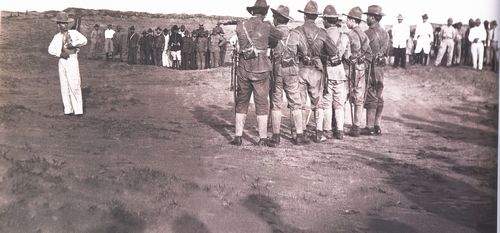 Maximiliano Lobo Guerrero: In 1915 a Carrancista agent discovered a group of counterfeiters. Some military personnel were involved and coronel Lobo Guerrero was convicted by an extraordinary Consejo de Guerra and shot General Francisco L. Urquizo, Recuerdo que …. However, El Pueblo (10 June 1915) states that Lobo Guerrero was accused of 'insubordination, usurpation of rank and functions, stealing $140,000 belonging to the Ejército Constitucionalista, and desertion while on campaign' so we might be accusing him unjustly.
Maximiliano Lobo Guerrero: In 1915 a Carrancista agent discovered a group of counterfeiters. Some military personnel were involved and coronel Lobo Guerrero was convicted by an extraordinary Consejo de Guerra and shot General Francisco L. Urquizo, Recuerdo que …. However, El Pueblo (10 June 1915) states that Lobo Guerrero was accused of 'insubordination, usurpation of rank and functions, stealing $140,000 belonging to the Ejército Constitucionalista, and desertion while on campaign' so we might be accusing him unjustly.
Jim Sigler, S. Thomson: In May 1915 a large quantity of counterfeit $50 Constitutionalist notes were circulating in Tampico, Tamaulipas. The authorities arrested four Americans, Jim Sigler, the owner of a nearby ranch, and S. Thomson and his two sons. They confessed to having bought $500,000 in fake notes from an American but had only put $20,000 into circulation. The notes were very coarse and also had a fake REVALIDADO seal. The Jefe de las Armas, Coronel Espinosa, had a conference with the American consul and they agreed that the counterfeiters would be deported, after they guaranteed to make good any loss that the public had sufferedEl Democráta, Veracruz, 27 May 1915. However, the New York Times a month later reported that three Americans, William Thompson, his brother, Robert, and a man named Segler, had recently been brought to Veracruz from Tampico charged with circulating counterfeit money. William Thompson had been released, according to reports received by Secretary Lansing, and his brother Robert would be. The charge against Segler appeared to be more serious, and his case was pendingNew York Times, 27 June 1915.
In August it was reported that four American residents of Tampico had been sentenced to long penitentiary terms for counterfeiting. It was reported that the Americans had been placed on board the Mexican gunboat Bravo and sent to VeracruzFort Worth Star-Telegram, 11 August 1915.
Humberto Taglelaubet, Lorenzo Aguilar, Rafael Dávalos, María Constanza and Matildo Medina: These were arrested on 28 May 1915 for counterfeiting 20c cartones. The experts at the Oficina Impresora de Estampillas admitted that they were very well madeEl Norte, 5 June 1915. However, another report was less complementary. It said that the cartones were badly counterfeited (burdamente falsificados) and were missing the seal. The cliches were made of copper, but so badly done that it was almost impossible to distinguish the main features and the cartones were printed by placing the cliches on the cardboard and then a heavy weight, so some impressions were blurred (El Renovador, 5 July 1915).
C. E. Bates: In June 1915 Bates, a cattleman of Nogales, was in jail at Carboca charged with introducing Carranza currencyTucson Daily Citizen, 22 June 1915. He was ordered brought to Nogales, where Consul Simpich expected his releaseTucson Daily Citizen, 25 June 1915.
Teófilo and Silvestre Durán, Carlos Quesada, Adolfo Rosas, Felipe Retana, Ernesta Cervantes and Damiana Estrada: These were arrested in a house in 12a calle de Mazatlán, colonia Vallejo, in the process of more than 500 20c cartones, Their tools consisted of two boards with lead matrices of the face and back of the notes. The police also found another ‘branch’ of the workshop at 1a calle de Regules, no. 10El Combate, 28 June 1915.
Federico González Barreda: On 30 June 1915 González Barreda, an employee of the O’Connor business house was arrested in Nuevo Laredo for possessing $800,000 in counterfeit Carrancista currency, with which he paid customs dues. González Barreda claimed that he bought the notes from Pilar García, brother of the Carrancista consul. The commonest counterfeit notes were for $100Prensa, 1 July 1915.
On 16 July it was stated that an investigation had disclosed that large sums of counterfeit Carranza currency had been printed in an American shop in Mexico City, smuggled out before the evacuation by the Zapata garrisonpresumably the last evacuation by Villistas on 10 July and taken to the United States by refugees who left Veracruz on the American army transport BufordDallas Morning News, 17 July 1915
Carlos E. Yerton
On 3 July 1915 the Inspector General de Policía in Tampico, Major Alberto M. Carranco reported that he had found $188,000 in counterfeit notes hidden in secret compartments in the luggage of the American Carlos E. YertonABarragán, caja I, exp. 8, f. 99 telegram Carranco to Carranza, 3 July 1915.
Barnes: In July 1915 the jefe militar of Tampico asked the authorities in Brownsville to arrest an American who had put a large amount of counterfeit money into circulation in Tampico. The Americans declined, as there was no recognisable government in Mexico. Three Americans, one named Barnes, were arrested in Tampico for circulating counterfeit Carrancista currencyPrensa, 23 July 1915. These might have been the following.
J. W. Bars (sic) and Eduardo Stari (sic)
On 13 July Inspector General Carranco found $37,000 in counterfeit $10 notes on the Americans J. W. Bars and banker Eduardo StariABarragán, caja I, exp. 8, f. 102 telegram Carranco to Carranza, 13 July 1915. Carranco had to hold Burns Stair incommunicado to prevent him warning othersABarragán, caja I, exp. 8, f. 104 telegram Carranco to Carranza, 28 July 1915.
Vaton y Socios
On 29 July Carranco named Vaton y Socios importers of counterfeit currencyABarragán, caja I, exp. 8, f. 104 telegram Carranco to Carranza, 28 July 1915.
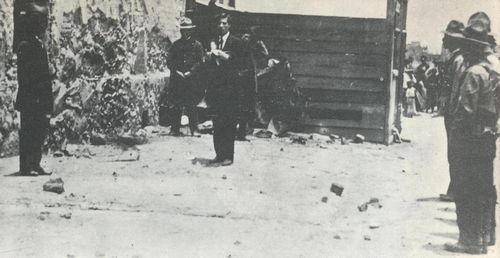 Carlos Meza; Carlos Meza was discovered by police with his wife in the act of counterfeiting 10c cartones. He was judged by the Consejo de Guerra and publicly executed in front of the Tercera Delegación de Policía on 19 August 1915. General Pablo González pardoned the wife and gave her money for her two childrenGeneral Francisco L. Urquizo, Recuerdo que ….
Carlos Meza; Carlos Meza was discovered by police with his wife in the act of counterfeiting 10c cartones. He was judged by the Consejo de Guerra and publicly executed in front of the Tercera Delegación de Policía on 19 August 1915. General Pablo González pardoned the wife and gave her money for her two childrenGeneral Francisco L. Urquizo, Recuerdo que ….
Carlos B. Bringas: In early September 1915, after various people had tried to change counterfeit notes at the Jefature de Hacienda, the police in Puebla undertook an investigation and arrested Miguel Rojas, Luis Vargas and Manuel D. León. They discovered that the counterfeiting operation was headed by General Carlos B. Bringas, and arrested him, his son, Mayor Carlos Bringas, and his wife, and recovered $47,000 in counterfeit notes, a strongbox with $74,000 in counterfeit notes and revalidados, $6,300 in silver and a quantity of gold. From Bringas’ accomplices they took $64,000 in new $100 revalidados altos, $18,300 in counterfeit $50 notes, $47,000 in $5 revalidados altos and $17,000 in dos caritasAT, Fondo Histórico, Sección Revolución Régimen Obregonista, Serie Hacienda y Guerra, Caja 55, Exp. 50; El Pueblo, 6 September 1915. Bringas and his son were transferred to Mexico City, where they were tried by a Consejo de Guerra, found guilty, and shot in the Escuela de Tiro on 24 SeptemberOf the other accused Manuel D. León and Miguel Rojas were sentenced to twelve years in prison whilst Bringas’s wife, Luz Belti de Bringas; Subteniente Arturo García, Francisco de la Portilla and José Garduño were acquited (El Pueblo, Año II, Tomo II, Núm. 351, 24 September 1915).
Iñigo Noreiga, Roberto Cárdenas, Refugio and Florencio Riquelme, Ernesto Cabrera: Special agents of General Provost J. Patiño had been closely watching Refugio C. de Cárdenas, who was accused of being an enemy of the Constitutionalist cause, and arrested her on 26 August 1915. At her home they found two copper plates for printing perfectly good $10 Gobierno Provisional (Veracruz) notes, and this led to the arrest of Refugio C. de Cárdenas, Mauricio Cárdenas, Roberto Cárdenas, Refugio Riquelme, Florencio Riquelme, Isabel Romero, Ernesto Cabrera, Iñigo Noriega, nephew of the Spanish millionaire of the same name, Elias Garcia, Luz Alonso and Ezequial Fernández. As soon as the arrests were made the prisoners were consigned to Provost General J. Patiño.
Roberto Cárdenas, the son of Señora Cárdenas and step son of Mauricio Cárdenas, who had already tried his hand at forging notes on previous occasions, was the one who conceived the idea of again counterfeiting paper money, and approached Florencio Riquelme, an engraver, whom he finally induced to join with the offer of magnificent profits. They then asked several people who refused to have anything to do in the matter. Among the parties approached was a photographer named Ernesto Cabrera, who, deceived by Cárdenas and Riquelme, took a photograph of a ten peso bill from which the clichés were made.
It appears that Noriega financed the scheme. Refugio Riquelme, Florencio Riquelme and his wife Isabel Romero, an elderly Spanish woman, were the ones who finally induced Noriega to join them in their enterprise. In an attempt to escape punishment Refugio Riquelme tried to throw the blame on his wife, whom he said induced him to commit the crime, but she denied this and claimed to have done everything in her power to prevent her husband from entering the scheme. Mauricio Cardenas, Señora Refugio C. de Cárdenas, Elias Garcia, Lux Alonso and Ezequial Fernández were declared innocent.
Provost General Patiño passed on his finding to General Pablo González who sentenced Noriega, Refugio and Florencio Riquelme and Roberto Cárdenas to deathThe Mexican Herald, 10 September 1915. The Delegado General of the Spanish Red Cross wrote to González, pleading for clemency for Refugio and Florencio Riquelme and NoriegaAPGG, leg. 12, exp. 106.
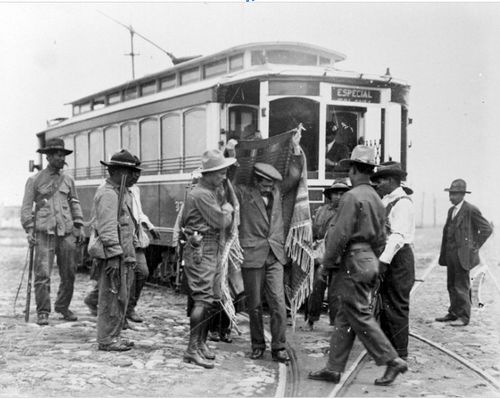
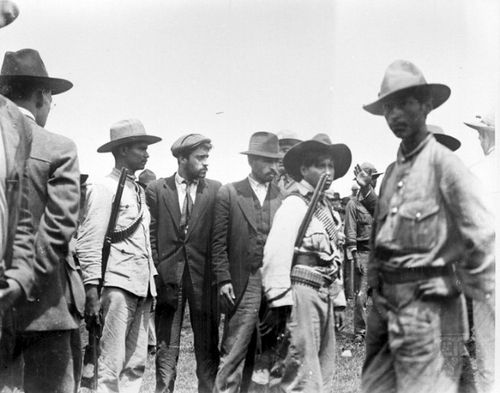
Florenco Riquelme, Roberto Cárdenas and Iñigo Noriega travelled by tram to the Escuela de Tiro
On 10 September Noriega, Florencio Riquelme and Roberto Cárdenas, were executed at the Escuela de Tiro in San Lazaro. A stay of execution was granted to Ernesto CabreraThe Mexican Herald, 11 September 1915; Prensa, 22 September 1915 and he was later sentenced to 20 years in prisonAPGG, leg. 2 Bis, exp. 10 letter J. Luis Patiño to Pablo González, 13 September 1916.
Estanislao Gutiérrez: On 21 September 1915 Gutiérrez was charged in Piedras Negras with circulating counterfeit money. He had a $20 Gobierno Provisional de Veracruz, serial number 322334 and $10 Gobierno Provisional de Veracruz, serial number 346936, and another $200ACOAH, Fondo Siglo XX, 1915, caja 24, folleto 3, exp. 4.
Constantino Méndez and Vicente Gómez: were arrested in Veracruz on 30 September 1915. Méndez, who had a ticket to leave on the American steamer 'México', made some purchases in the shop of Juan Arau, paying with notes that were brand new and with consecutive numbers. A suspicious Arau notified the police who found a large quantity of similar counterfeit notes in Méndez’ cases. Bogus $5, $10 and $20 notes were discovered in a trunk in Mendéz’ hotel room. Vicente Gómez was detained as an accompliceEl Pueblo, 1 October 1915.
Baldomero Ricaldi: On 3 October 1915 the Spaniard Baldomero Ricaldi was apprehended in Mexico City with a handbag containing $60,405 in counterfeit $5, $10 and $20 notesEl Pueblo, Año II, Tomo II, Núm. 361, 4 October 1915.
Juan Gómez: On 29 October Coronel P. Morales Elizondo, Juez Instructor Militar of the Cuerpo de Ejército del Noreste in Monterrey, acknowleged receipt of $4,295 in Constitutionalist notes of different values, that were believed to be counterfeit, taken from Juan Gómez.AMM, Colección Civil, volumen 462, exp. 12.
José Woo: Woo, the Chinese owner of the Hotel Central, in San Luis Potosí, and six other Chinese were arrested in October 1915. The authorities were keen to execute them but the French vice-consul and American consul managed to secure their releasePrensa, 31 October 1915.
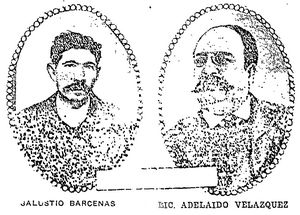
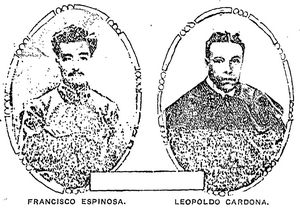
Salustio Bárcenas, Leopoldo Cardona, Francisco Espinosa, and Adelaido VelázquezAdelaido Velázquez was a 52-year-old lawyer, living at 3a calle de la Violeta no. 63; Leopoldo Cardona, a 33-year-old businessman, living at 4a calle de Lerdo no. 124; Salustio Bárcenas, a 32-year-old printer, living at callejón de Niño Perdido no. 24; and Francisco Espinosa, a 24-year-old deaf-mute litographer, from Zamora, Michoacán, living at 2a calle de Cocheras no. 70: These were arrested by the Policía Especial de la Comandancia Militar, along with their equipment and false currency (cartonesThe cartones were 5c, 10c and 20c Gobierno Provisional de México (El Demócrata, Guadalajara,12 November 1915) and sábanas), and confessed their crime. They had been involved in a plant for bottling wine and so acquired the press and other lithographic equipment needed to print labels, but from mid-1913 had found it more productive to produce cartones and notes.
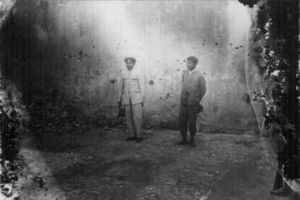 Velázquez, Cardona and Bárcenas were sentenced to death: Espinosa to ten years imprisonment. Bárcenas and Velázquez were shot in the Escuela de Tiro on the morning of 13 November. Cardona escaped from his prison in the main gate of the Palacio Nacional, whilst under the watch of teniente Felipe Acevedo. Teniente Acevedo y cabo José Aguilar were shot for allowing him to escapeEl Pueblo, 13 November 1915.
Velázquez, Cardona and Bárcenas were sentenced to death: Espinosa to ten years imprisonment. Bárcenas and Velázquez were shot in the Escuela de Tiro on the morning of 13 November. Cardona escaped from his prison in the main gate of the Palacio Nacional, whilst under the watch of teniente Felipe Acevedo. Teniente Acevedo y cabo José Aguilar were shot for allowing him to escapeEl Pueblo, 13 November 1915.
Edilberto Valdés: was arrested in Saltillo on 20 November 1915, and found to have 425 counterfeit $5 Gobierno Provisional notesACOAH, Fondo Siglo XX, 1915, caja 39, folleto 5, exp.1.
Manuel González Montenegro, José Santos Gómez, and José G. Gallegos: were shot on 10 December 1915 for counterfeiting Constitutionalist money. Santos Gómez was a printer and, with various others, was caught by the Comisario of the Policía Judicial Militar, coronel Fernando L. Echegaray, while counterfeiting 10c cartones in a house in the Calle del Topacio. The pólice recovered a “Eugenio Brisset” lithographic press with all its accesories, various sheets of complete cartones and other blank sheets, inks, tools and two clichesEl Democrata, Tomo II, Núm. 374, 10 December 1915. They were condemned to death by Pablo González and shot in the Escuela del Tiro.
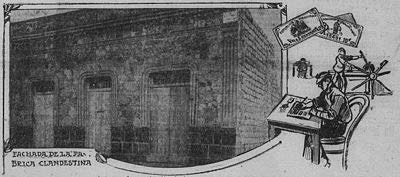 Antonio Bauza: For several weeks Mayor Barrera, Jefe de la Policía del Cuartel General del Cuerpo de Ejército de Oriente, had been aware that quantities of counterfeit, mainly $10, notes were being distributed to various part of Mexico. His agents, Oniveros and Reventer, kept a watch on several Spaniards, Antonio Bauza, his brother Vicente Bauza, Manuel Lamadrid, and José Castro. Antonio Bauza was the owner of a grocery store named “Nico y San Rafael”, in the calzada de San Antonio Abad, where the others met.
Antonio Bauza: For several weeks Mayor Barrera, Jefe de la Policía del Cuartel General del Cuerpo de Ejército de Oriente, had been aware that quantities of counterfeit, mainly $10, notes were being distributed to various part of Mexico. His agents, Oniveros and Reventer, kept a watch on several Spaniards, Antonio Bauza, his brother Vicente Bauza, Manuel Lamadrid, and José Castro. Antonio Bauza was the owner of a grocery store named “Nico y San Rafael”, in the calzada de San Antonio Abad, where the others met.
When arrested Bauza tried to get rid of $270 in counterfeit notes that he had on him. The police then captured Manuel Vega, Manuel González Eguen, Manuel Casisedo, Juan C. Moreno, José González, José Arredendo and a German called Pul TeushnerEl Demócrata, 29 February 1916.
In August 1916 Manuel Lamadrid wrote to the Spanish legation complaining that he had been in prison since 14 February, sentenced, though innocent, to six months imprisonment and a $1,000 fine (converted into another 100 days for non-payment) for attempted bribery (tentativa de cohecho). It was he who had denounced the counterfeiters, and he had not been judged by any court but by General Pablo González. On 21 August Alejandro Padilla, the Spanish Minister, wrote to González asking for Lamadrid to be let off the fine and González replied that he had no objection but as the competent authority was the Gobierno del Distrito, he was passing on the request to CarranzaAPGG, leg. 6, exp. 8.
Instances in the United States
In July 1915 Ramón P. de Negri, the consular agent in San Francisco wrote to Eliseo Arrendondo, Carranza’s confidential agent in Washington, “I have discovered the person who is printing counterfeit paper currency, to whom it has been sent and who is selling it. They are today printing bills of the latest Carrancista and Villista issues. I yesterday sent a secret agent and he was told that they could sell as many as fifty millions daily that they print. Authorities here have declared themselves powerless to prosecute crime. I beg you to use your good offices with authorities over there so that they may help me to have these malefactors brought to justice.”. Arrendondo wrote to Robert Lansing, the Secretary of StateSD papers, 812.5157/89 letter Arrendondo to Lansing, 13 July 1915. On 15 July de Negri informed Arrendondo that he had discovered that three individuals were engaged in the printing of false notes and that by the next Saturday he expected to lay his hands on one million of themSD papers, 812.5157/91.Two days later he reported that state officials considered themselves powerless to punish this crime in accordance with the law, and wanted the cooperation of the federal authoritiesSD papers, 812.5157/94.
On 15 September 1915 Jose J. Pesqueira, Carrancista consul in St. Louis, asked the Assistant United States District Attorney to order the arrest of five Mexicans in the city who, he said, were counterfeiting Carranza money, and sending it to Mexico. The latter replied he could not act as the Carranza Government had not been recognized by the United States. Pesqueira said that millions of dollars in Carranza currency had been counterfeited in Chicago and St. Louis, and that as a result of the flood of counterfeits sent to Mexico, the genuine Carranza money has depreciated. The case was turned over to a secret service operativeDallas Morning News, 16 September 1915.
Carlos Flores García, Russek, Jacobo Harootian: In September 1915 Luis Cabrera wrote to Carranza from New York that the counterfeiters in Texas had organised a distribution network throughout the States, Cuba and Guatemala. The leader in San Antonio was Carlos Flores García,an ex army paymaster, in El Paso Russek, while the Federal ex-general, Jacobo Harootian, managed distribution in Havana. The press was in Kansas City and they were preparing to counterfeit the new issueCEHM, Fondo XXI, carpeta , legajo 5815 letter Luis Cabrera, Nueva York, to Carranza, 24 September 1915.
In early August 1916, Secret Service Agent Hazen of the United States Treasury Department stopped a firm of printers in Los Angeles, who, not understanding the status of Mexican currency, had arranged to print $300,000 worth of Carranza paper money. As Carranza had been recognised by President Wilson, this was believed to be an implication that acts of counterfeiting would finally be prosecutedLos Angeles Times, 5 August 1916.
In September 1916 three defendants were set for trial in the Federal Court in Los Angeles, for having counterfeit Carranza money in their possession that they sold in large quantitiesLos Angeles Times, 5 August 1916.
Other instances of counterfeiting
For the following cases more information is required before we can identify what currency was being counterfeited.
Juan Manuel Serrano and Jesús Garza Vargas: in June 1914 Nicéforo Zambrano, the Presidente Municipal of Monterrey reported that these had $5 billetes Constitucionalistas, that were presumed false,and so had been consigned to the authorities. There had been similar cases in the last few daysANL, Correspondencia de Alcaldes: Monterrey, caja 128 letter Nicéforo Zambrano, Presidente Municipal, Monterrey to Srio de Gobierno, 15 June 1914
Francisco Ajón and Baltasar Arvizo: in October 1914 Villa’s agent reported that Francisco Ajón and Baltasar Arvizo were circulating counterfeit money in Baja CaliforniaCEHM, Archivo Federico González Garza, carpeta 37, legajo 3596 report 12-17 October 1914.
Heriberto Hernández: in December 1914 this counterfeiter, was forgiven by [ ] because the caudillo considered his work as an engraver admirable and even helped him with money to cure himself of his pneumonia and so that he could dedicate himself to an honest lifeEl Democráta, 26 December 1914.
Rafael Marín: was aprehended a few days ago in Colonia de la Bolsa in June 1915 but escaped a few days laterEl Norte, 4 June 1915.
Estanislao Gutiérrez, José López Zuazua: Gutiérrez was committed to the Juzgado de Primera Instancia, for circulating counterfeit money in Piedras Negras, 15 November 1915. His accomplice was José López Zuazua, The counterfeit notes were in the possession of General Celso Castro in Piedras Negras, so Gutiérrez asked to transfer thereACoah, Fondo Siglo XX, 1915, caja 38, folleto 6, exp.2.
María Sandoval: María Sandoval viuda de Guerrero, of Mexico City, complained to Pablo González that her house was searched and various pieces of furniture, including a piano, sewing machine, phonograph, removed. Mayor Hector de Ita was one who was involved. On 4 December Nestor Gonzalez, from Guadalupe Hidalgo, writing a reference for Maria Sandoval to Mayor Adolfo España, Mixcoac, said that it was claimed that they found counterfeit plates (cliches para falsificar billetes de banco) but that she would have nothing to do with such a crime, By 6 December de Ita had been detainedAPGonzález, leg. 13, exp.70) (roll 13).
Carlos Prieto (elsewhere Ibarra): Prieto was accused of circulating counterfeit notes in Agua Prieta in early 1915. On 15 January 1916 he was arrested in Cananea and, as the local judge refused the case, assigned to the military authorities and transferred to Hermosillo AGHES, Oficialia Mayor, tomo 3082, letter Procurador General Militar y de la Nación, Nexico City, to General Comandante Militar de la Plaza, Hermosillo, 4 February 1916.
Pablo Ruvelo: On 31 July 1916 agents reported on a printing press that had been seized from premises on the corner of calle Bolivar and San Jerónimo two months earlier. The owner was a Pedro Kuri, currently living in Durango, and he had rented it to Pablo Ruvelo, supposedly in Havana, who had been accused of counterfeiting banknotes and cartonesAPGonzález, leg. 7, exp. 131 letter Armando Morales Punte to Pablo González, Cuernavaca, 1 August 1916.
and in the U.S.
In May 1915 $1,000, 000 in counterfeit Mexican money (the result of a year’s seizures by the El Paso police department) was destroyed at the city disposal plantEl Paso Herald, 12 May 1915.
A. S. Richards: In October 1916 James M. Wright, a federal secret service man from Atlanta, confiscated $280,000 in counterfeit Mexican money held by A. S. Richards, a Tampa grocer, who bought the money at a sale of unclaimed articles by an express company about six weeks before. The money was in an old trunk sent from Key West and Richards had no idea of what he was buyingColumbus Daily Enquirer, 30 October 1916.
